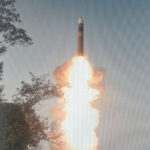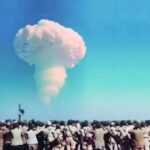Nunn-Lugar: 20 years of Cooperative Threat Reduction
By Kennette Benedict | December 19, 2011
December 12 marked the 20th anniversary of the Cooperative Threat Reduction legislation introduced by US Senators Sam Nunn and Richard Lugar to aid Russia in dismantling its nuclear arsenal after the end of the Cold War. The program created by that initial legislation is the most significant and successful postwar effort since the German Marshall Plan helped Europe recover from World War II.
The Cooperative Threat Reduction Program has deactivated 7,527 strategic nuclear warheads and destroyed 774 intercontinental ballistic missiles, 651 submarine launched ballistic missiles, and 906 nuclear air-to-surface missiles. It has upgraded security at 24 nuclear weapons storage sites in Russia and downblended 400 metric tons of highly enriched uranium, which now supplies 10 percent of US electricity. To date, the Nunn-Lugar program has reduced nuclear arsenals in Russia from 30,000 in 1991 to about 12,000 warheads today. To match the effort in Russia, the United States has dismantled more than 13,000 warheads since 1990 and destroyed 90 percent of its nonstrategic nuclear weapons, going from 7,600 to 760 warheads. It took nearly 50 years to build the most dangerous arsenals in history; it has taken less than 20 years to dismantle and store more than 75 percent of the world’s nuclear weapons. This is a moment for celebration.
Yet, there will likely be little fanfare to recognize these accomplishments, nor much praise for those far-sighted and generous leaders who created the organizations to carry out the most complex weapons dismantlement in history. Why? For those interested in the increased security that fewer nuclear weapons bring, the failure to focus on this Herculean effort is a puzzle indeed. So, how can we account for the apparent lack of enthusiasm for an extraordinarily successful initiative?
Ambivalence. On the Russian side, there may be individuals who view America’s assistance in dismantling their nuclear weapons as an assault on their country’s sovereignty and an affront to their perceived superpower status. As there was no defining military victory or surrender to end the Cold War, US assistance with the drawdown of forces may seem humiliating — especially to the Russian military. Likewise, among US leaders who see the Soviet collapse as solely a triumph of the West, the thought of helping a vanquished foe — even to disarm it — makes no sense: The Soviets dug the economic hole they’re in; why should the United States lend a hand to help get them back on their feet? To some, providing funds to dismantle Russian weapons to help Russia meet its own treaty obligations seems to reward the Soviets/Russians for their past bad behavior.
Cooperation between the United States and Russia to dismantle nuclear weapons finds favor with neither of these groups. At best, they are ambivalent about the Nunn-Lugar program.
Too little, too late. For another group, advocates of nuclear disarmament, the US assistance program may seem like too small an effort — at about $500 million annually — that is taking much too long. After all, as impressive as the results may be, after 20 years the two sides are not yet close to zero weapons. The program drags on, with the US Congress grudgingly appropriating funds from year to year with little sense of the incredible significance of the cooperation between two governments that spent half a century on the brink of nuclear war.
Meanwhile, as the United States and Russia have taken their time with nuclear weapons dismantlement, the argument goes, other countries — India, Pakistan, and North Korea — have joined the nuclear club. The lag between the start of the program and its successful completion is seen as evidence of a lack of commitment to abolishing nuclear weapons. This provides non-nuclear states with a rationale for their own nuclear weapons proliferation.
Boring arms control. A third reason that the champagne corks won’t be popping on this 20th anniversary of the Nunn-Lugar program is, as international security intellectual Lawrence Freedman puts it, arms control is “so boring.” When all the drama and brinksmanship of hostility between enemies is over, the important footwork to build peace and security just doesn’t seem that exciting. After all, even the kind of arms control that leads to dramatic reductions in nuclear weapons is essentially an exercise in accounting. Dismantling warheads involves tedious and ultimately tiresome counting, storing, and controlling of inventory. These are not the actions of heroes and villains, but rather the ministrations of bureaucrats, engineers, and accountants. Nevertheless, they are the very steps that will prevent a nuclear holocaust, safeguard weapons materials, and increase global security.
Given what’s at stake, then, controlling and dismantling nuclear weapons also takes on the other definition of “boring”: to move ahead steadily against resistance; to push ahead with constant, irresistible force. Dismantling vast nuclear arsenals demands epic patience and unflagging perseverance against the pressures of organizational inertia and the power of vested interests. It requires laser-like focus and a passion for security and public safety that is not distracted by developments in emerging nuclear states like Iran and North Korea.
On the long slog toward the reduction or even elimination of nuclear weapons, there is a temptation to relieve the monotony — the boringness — of the process by leaping to the adrenaline-producing battles over missile defense programs or to the metaphoric fisticuffs with potential new nuclear states. To be sure, yielding to such temptation is not always wrong; the history of war can be read as reactions to surprise and to previous failures to anticipate military actions, resist them, and thus prevent wider war. So it is smart to attend to the small numbers of new nuclear weapons states and their potential for conflict. Yet, it would be a greater failure if the United States substituted the visceral drama of relatively small nuclear threats for the boring task of cleaning out the Augean stables of the world’s most lethal nuclear weapons. It’s time to celebrate the accomplishments of the Cooperative Threat Reduction Program; it’s also time to finish the job.
Together, we make the world safer.
The Bulletin elevates expert voices above the noise. But as an independent nonprofit organization, our operations depend on the support of readers like you. Help us continue to deliver quality journalism that holds leaders accountable. Your support of our work at any level is important. In return, we promise our coverage will be understandable, influential, vigilant, solution-oriented, and fair-minded. Together we can make a difference.
Topics: Columnists, Nuclear Weapons















